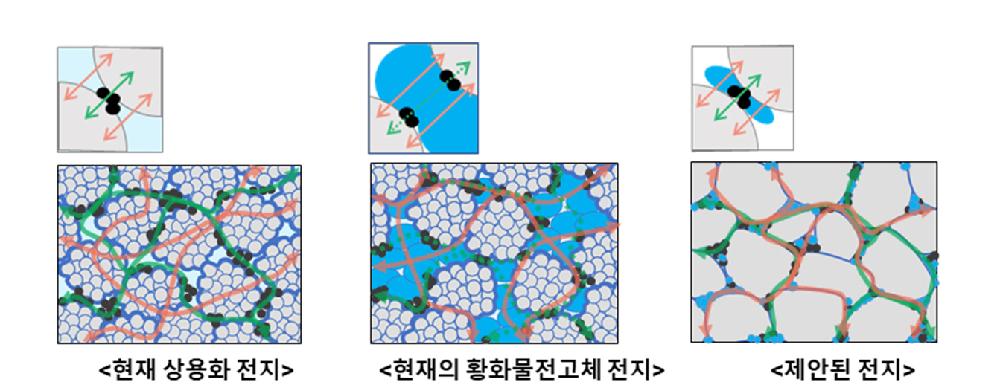커뮤니티
부경투데이
- 국립 부경대학교의 다양한 모습과 소식을 접하시면 부경대학교가 한번 더 가까워집니다.
| 차세대 대용량 전지 상용화 앞당긴다(Next generation high-capacity battery will be commercialized soon) | |||
| 작성자 | 대외협력과 | 작성일 | 2019-06-11 |
| 조회수 | 640 | ||
| 차세대 대용량 전지 상용화 앞당긴다(Next generation high-capacity battery will be commercialized soon) | |||||
 |
대외협력과 |  |
2019-06-11 |  |
640 |

|
부경대학교 오필건 교수(인쇄정보공학과·사진)는 최근 황화물계 전고체 전지의 상용화를 위한 연구를 진행, 기존 전지의 효율을 20 % 개선하면서 전극 내 전해질 비율을 감소시켜 전지의 에너지 밀도를 크게 향상시키는 연구결과를 제시했다. 전고체 전지란 가연성의 액체전해질을 사용하는 리튬이온전지와 달리 불연성의 고체전해질을 사용하는 전지다. 폭발이나 화재의 위험이 없어 산화물계열, 고분자계열, 황화물계열로 상용화 연구가 진행되고 있지만, 에너지 밀도가 낮고 상온에서 출력특성이 저하되는 등의 문제로 상용화에 어려움을 겪어 왔다. 오 교수는 이번 연구에서 현재 전고체 전지 연구의 문제점을 전극 내 높은 전해질 비율이라고 지적하고, 일차입자 형태의 NCM(니켈코발트망간산화물) 양극 소재를 활용한 새로운 고밀도‧고출력의 전극 설계를 제시해 전고체 전지의 상용화를 크게 앞당겼다는 평가를 받고 있다.
그는 “황화물계 전고체 전지는 다른 전고체 전지에 비해 높은 출력특성을 보이지만, 현재의 연구는 기존 개발된 소재를 이용해 전극 성능을 최적화하는 상향식(Bottom-up) 방식에 그치면서 출력성능과 에너지 밀도가 매우 부족하다.”면서, “상용화 리튬이차전지보다 우수한 전지 특성을 확보하려면 전고체 전지의 이상적인 전극 설계를 확보한 후, 그 설계를 가능하게 하는 최적 소재를 개발하는 하향식(Top-down) 방식의 새로운 연구 패러다임이 반드시 필요하다.”고 주장했다. 이 연구결과를 담은 논문 ‘Advances and Prospects of Sulfide All‐solid‐state Lithium Batteries via One‐to‐one Comparison with Conventional Liquid Lithium Ion Batteries’는 에너지, 재료 분야의 국제저널 ‘Advanced Materials’(IF 21.95)에 최근 게재됐다. 한편 오 교수는 새로운 전고체 전지 전극 설계기술뿐만 아니라, 전고체 전지만의 열화 메커니즘 연구 및 개선 연구를 진행하고 있으며, 이를 평가하기 위한 황화물계 전고체 전지 전용 랩을 구축 중이다. <부경투데이> Growing concerns about the safety problem of large-capacity secondary batteries used in electric vehicles, researches on high-energy batteries for commercialization of next-generation solid-state batteries without explosion risk are getting attention. Professor Oh Pil-gun of Pukyong National University (Dept. of Graphic Arts Information Engineering, see photo) has been conducting research on the commercialization of sulfide-based solid-state batteries, the research results show that the efficiency of existing batteries is improved by 20 % while the ratio of electrolyte in the electrodes is reduced to greatly improve the energy density of the cells. A solid-state battery is a battery that uses a non-combustible solid electrolyte, unlike a lithium ion battery that uses a flammable liquid electrolyte. Although there is no risk of explosion or fire, commercialization of oxides, polymers, and sulfides has been conducted, but it has been difficult to commercialize them because of low energy density and declined output characteristics at ordinary temperature. Professor Oh pointed out the problems of current solid-state battery research in the present study as a high electrolyte ratio in the electrode, and proposed a new high-density, high-output electrode design using primary particle type NCM (nickel cobalt manganese oxide) and it is evaluated that he has greatly advanced commercialization of solid state battery. Professor Oh said, "So far, all previous solid-state battery studies have made electrode designs with higher electrolyte ratios of over 10% to improve the high interfacial resistance between the active-solid electrolytes. As a result, the energy density of the electrode is lowered, and the electron transport path in the electrode is blocked due to the high ratio of the electrolyte, thereby greatly increasing the electron resistance." He said "Sulfide-based solid-state batteries have higher output power than the others, but Current research has shown that the bottom-up method, which optimizes the electrode performance using existing materials, is very poor in output performance and energy density." and added, "In order to secure better battery characteristics than commercialized lithium secondary batteries, we have developed a top-down system that develops the ideal electrode that enables the design of an ideal solid electrolyte battery and a new top-down research paradigm is needed to develop the optimal materials that enable the design." The paper, "Advances and Prospects of Sulfide All-solid-state Lithium Batteries via One-to-one Comparison with Conventional Liquid Lithium Ion Batteries", is published in Advanced Materials (IF 21.95) Recently published. Professor Oh is not only designing a new all-solid-state battery electrode technology, but also researching and improving the deterioration mechanism of only the entire solid-state battery and building a dedicated lithium sulfide-based battery to evaluate this. <Pukyong Today> |

 전기차 등에 사용되는 대용량 이차전지의 안전성 문제가 대두되는 가운데 폭발 위험이 없는 차세대 전고체 전지를 상용화하기 위한 전지 고에너지화 연구결과가 나와 주목받고 있다.
전기차 등에 사용되는 대용량 이차전지의 안전성 문제가 대두되는 가운데 폭발 위험이 없는 차세대 전고체 전지를 상용화하기 위한 전지 고에너지화 연구결과가 나와 주목받고 있다.